
Chapter Eight:
Keeping Your Cat Active
with Personal Interaction

No matter how aloof your cat pretends to be (or actually is), it is likely that she enjoys interacting with you. She probably even craves your attention or at least your hand on one of her favorite toys. This chapter is dedicated to uncovering ways you can interact with your cat to keep her stimulated. Since you cannot be the source of your cat’s constant entertainment, the following chapter addresses ways you can create an environment where she can entertain herself.
This section highlights the different ways that cats play and the benefit they receive from each form of engagement. It examines ways that you can interact with your cat to keep her physically fit while creating a stronger bond between the two of you. We’ll also take a look at ways that you and your cat can contribute to the community. As you consider these fun suggestions, remember that what your cat will enjoy most is entirely dependent on her personality and preferences. Experiment with these suggestions and employ regularly the activities she seems to enjoy the most.
Playing With Your Cat
According to http://pet360.com, play sessions for indoor cats — which can include social play and object play — need to be frequent and regular. Watching a kitten play can be highly entertaining for us. For them, play is a complex learning activity that helps develop social relationships as well as physical and mental skills (Commings 2015). When adult cats have moments where they play just like a kitten, it can be one of the most adorable moments to witness as a pet owner. You can encourage this behavior as you interact with your cat and provide them with toys and structures to play and release their energy.
You should aim for three play sessions each day; use different toys in each session to ensure that your cat is finished playing, not just bored with a particular toy (http://pet360.com). To prolong your cat’s interest in a particular toy, you can sprinkle it with a bit of catnip, but remember that cats need variety as much as they need engagement.
Social play
Social play refers to how kittens interact with their littermates, their mothers, other pets and you. During social play, kittens investigate and test their world to discover how they fit into it. Their personalities will develop based on their playful interactions with other animals and humans (Commings 2015).
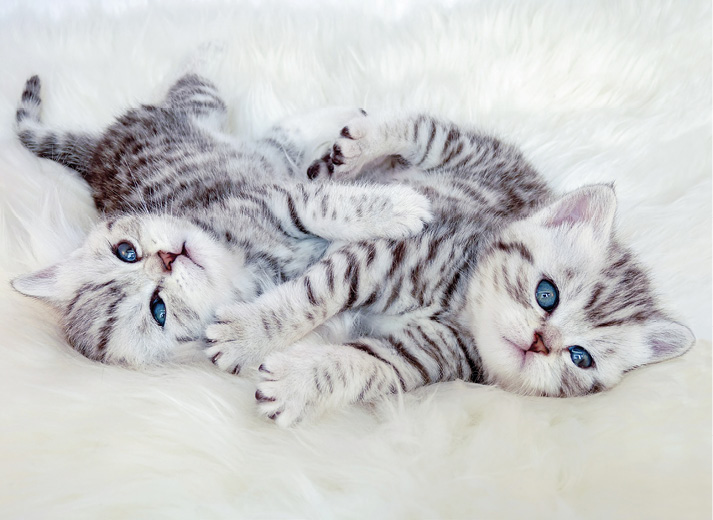
Encourage social play with your young cat. Engage him or her with more than just a toy. Playing with your kitten can be a powerful bonding and training tool, and you should make a point to actively play with her at least 20 minutes at a time, three times per day. Longer and more frequent play sessions prove even more beneficial if you have the time (Shojai 2002).
You can pet your cat, comb her and trim her nails. You can also scratch her belly, hide treats from her, encourage her to find them, and find other ways to personally interact with her. If you are raising a litter, the more you handle your kittens, the more comfortable they will be if you give them away. If you plan to raise and keep your kitten for life, early physical bonding can start your relationship off on the right track.
Being an active participant in social play means that you need to monitor your kitten’s interactions with other pets (including an older, adult cat, other kittens, puppies, or even dogs) to make sure he or she is experiencing positive social play in his or her developing months. If you are raising a kitten among children, you might want to involve them in early social play so that both parties know how to interact with each other (teaching young children how not to hurt the kitten while teaching kittens not to scratch or bite your children).
Object play
As the name would suggest, object play is when your kitten is playing, poking, batting, or chasing objects. During these play sessions, your kitten develops skills she can use to hunt prey if she were in the wild. In your home, she is simply getting her energy out and keeping her body and mind engaged in activity.
You can engage your kitten or cat in object play by playing with a toy or by creating a play space where your cat can interact with toys alone. Both options are important, as you want to strengthen your bond with your cat, but also allow her to be active even when it does not fit with your schedule, particularly if your cat gets in touch with her nocturnal side.
Locomotor play
Running and jumping helps increase a kitten’s strength, coordination, and flexibility (Commings 2015). This type of play also stimulates your cat’s appetite while keeping her fit. But most importantly, this form of play prevents boredom while stimulating your cat’s body and mind. Experts suggest that active play sessions at night can reduce your cat’s nocturnal wanderings, which can often lead to your cat waking you up.
Physical interaction
Depending on a cat’s personality, she may or may not enjoy a good rub down. Furthermore, how she enjoys that rub down may take on many different forms. Some cats will curl up in your lap and let you give them attention, while others will sit by you or in front of you, but they do not want to be held. Others want and enjoy your attention, but want you to come to them. There is a reason why almost all cat owners at some point in time wonder who is the real “master” of the house.
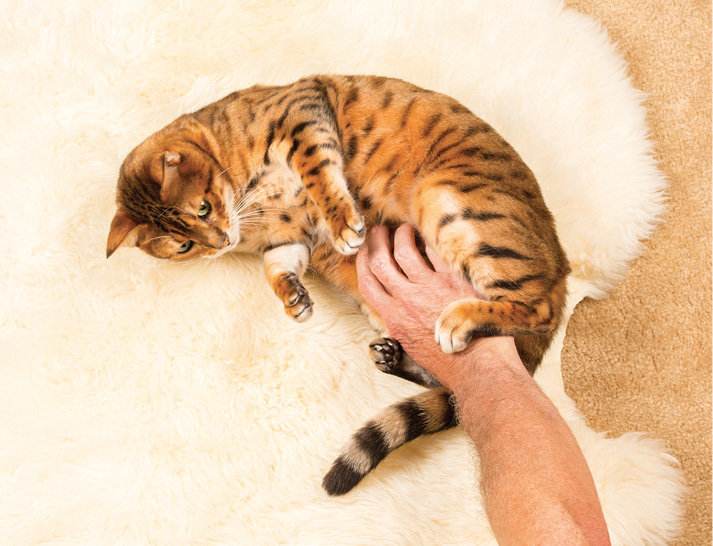
As the graphic above indicates, you should use caution when petting a cat’s stomach or back legs unless you know her well and are sure she will enjoy it.
For every rule, there is an exception; some cats actually enjoy a good belly rub. However, you should be cautious of touching any cat in an area that has been exposed to surgery or shots after a vet visit.
Regardless of personality, if a kitten is handled when he is young (after the age where it is appropriate to start playing with them), he is more likely to be comfortable with hands-on affection. While it might be necessary to handle a kitten earlier (say if the mother has given birth in an unsafe spot), waiting until the kittens have opened their eyes and ears is ideal (somewhere between two and four weeks of age) (Foster 2015). After all, a kitten with eyes and ears wide open is likely to be more alert and enjoy playing with you more anyway.
While all cats are different, there are definitely areas of a cat’s anatomy that are more likely to get a positive reaction than others. If you want to make sure you establish a solid hands-on connection with your cat early in life, most cats enjoy being stroked or rubbed around the ears and chest (Edney 2006). A relaxed cat might enjoy being petted on her neck or back. Other areas are more up in the air; see the chart below for a somewhat humorous guide to safe petting zones:

The bottom line is: learn your cat’s preferences and give her rubdowns where she wants them, not where you want to give them. Otherwise, you should be prepared for hand scratches and playful (or not so playful) biting.
Words of caution
While playing with your kitten or cat should be great amount of fun for both of you, there are a few play strategies you should avoid. Even if you think your cat’s behavior is adorable and you have learned to prevent injury to yourself, you should still discourage overly aggressive behavior from your feline. If you foster these behaviors, it could prove negative in the long run. Follow these next three recommendations when possible.
Do not play with your kitten too early
Unless you have a kitten that was born in your home, it is unlikely you will own your little felines when they are less than four weeks old. However, if you do, you should know — and communicate to your children — that during their first month of life, kittens are too busy nursing, sleeping, and learning to be played with. Handling a kitten during these early weeks of development can prove detrimental to their health.
Once you see your kittens start to interact and play with each other, you can start to get to know them a bit and offer them some kitten-safe toys to interact with. From two to three months of age, kitten will be extremely active and will need your attention during play time to make sure they do not get in trouble or get hurt. So, while you might need to wait a few weeks to play with them, know that the time will come when your kitten will want plenty of your time and attention.
Do not allow your cat to hunt you
It might seem innocent or even fun to play or tease your cat with your hand or foot, but you should not allow your cat to use body parts as prey, because it could lead to injury (http://pet360.com). Your cat’s natural tendency to pounce and attack objects could lead to your cat attacking parts of your body innocently — have you ever moved your foot under your blanket just to feel your cat’s teeth seconds later? Encouraging caution will benefit you and possibly prevent ill feelings with a future guest.
Do not allow your cat to bite or scratch you
Many cats bite or scratch when they play with each other. These same cats might be prone to bite or scratch you when playing if you allow it. Even if you think of this as a fun game and are willing to endure a little pain for the playful interaction, you should not train your cat that this is acceptable interaction with people. If your cat plays with you like that, she might be likely to do this with someone else and that could lead to injury.
This is particularly important to remember if you want to pet her belly. Keep in mind that how she plays with you will probably be how she plays with others. If you know she is prone to biting or scratching when someone does something in particular, be sure to warn anyone who handles her of that risk. Discouraging your cat from scratching humans in her play time is an excellent way to avoid putting her in a situation where declawing (which most experts and vets recommend against) becomes necessary.
Remember that your cat’s claws are retractable and no matter how willful she is, you can teach her to play without extending them. If you simply stop playing with your cat when she uses her claws, that should be enough to teach her to keep them retracted. You do not need to yell or smack your cat as a form of discipline.
Cat Training
You might not think about the work that goes into getting cats to “perform” in front of the camera when you see them on television or in movies. In fact, the only training that you might have experienced in your home is your cat training you to fill her bowl on time. However, if you sit through an animal show at a theme park, you start to realize that cats really are trainable.
Most likely, you have trained your cats to a limited extent without really thinking about it in those terms. Teaching your cat to use a litter box, where to look for food, or to use a scratching post instead of damaging your furniture are training achievements. Some experts tell us cats are actually capable of much more.
Amy Shojai, a recognized expert on pet care and behavior, explains in her book, “Complete Kitten Care,” that while kittenhood is the ideal time to begin training, a cat can be taught positive and negative behavior at any age: “Training your kitten teaches him what to expect in terms of behavior. It prepares him for life with people, prevents normal behaviors from turning into problems, and rewards both you and your kitten with a stress-free, loving relationship” (Shojai 2002).
Shojai explains that the key to training your cat is to find something that motivates your feline family member and use it to reward the behavior you want to encourage. She wants you to associate your cat’s name with positive messages and a negative sound with behavior you want your cat to end. Shojai warns that the negative sound (a firm “no” or a “hiss”) should be used sparingly and that yelling at your cat will probably do little except make your cat want to avoid you.
She also explains that to effectively connect behavior with results, the training must be closely connected in time. If you attempt to correct a cat for behavior that occurred hours ago, the message will not make an impact. For that reason, training must be a proactive activity, not something you do as a response when you get home and your cat has shredded your favorite throw pillow. Shojai explains that play is probably one of the most best training tools for cats – especially kittens. If you want to train your cat in a certain activity, consider finding a way to make the activity a game for your feline.
In the meantime, review the following recommendations for training that every cat (and cat owner) needs.
Litter box training
Kittens learn what a litter box is by following mom and doing what she does. However, if your kitten is very young or you rescued a stray, you will need to train your cat to use the litter box yourself. To do so you will have to frequently put your cat in the box, help her scratch the litter a bit, and perhaps even leave a little “deposit” in the box to help her remember what this space is for. Make sure to leave your litter box in a place that is easy to find, but away from your cat’s food, water, and sleeping spot.
Scratching posts
A cat does not scratch simply to sharpen his claws or destroy your furniture; scratching is ingrained into a cat’s instinctual behavior. This is not a behavior you will be able to (or should attempt to) alter, but you can train your cat to scratch in a “safe” spot or spots. Please do not attempt to solve this problem by having your cat’s claws removed. That ignores the benefits a cat receives from scratching, which range from conditioning claws to stretching his muscles. Other reasons include:
- Stress release. Your cat scratches as an emotional release so that when he is anxious, happy, excited, or frustrated; he might express that by scratching.
- Trims their claws. Scratching does not just “sharpen” a cat’s claws, if the scratching is done on the right material, it can also help keep their claws from getting too long.
- Marking their territory. Cats instinctively leave claw marks as an advanced warning system to reduce the number of confrontations they have with other cats. While this is not necessary in your home, it still might make your cat feel more secure to engage in this behavior.
Once you understand that your cat needs to scratch, you can prioritize providing your pet a good place to engage in this activity and training him to use it. Training begins with a good, solid scratching post, which means it needs to meet certain qualifications, including appealing texture and a tall and stable build. The texture of the material that the post is made from should be rough, but also easy to dig claws into for a “good scratch.” You should also select a scratching post that will not lead to your cat getting his claws caught in it if it starts to come apart.
The height and structure of a scratching post is also important; the way your cat’s scratching post is built should enable him to get a “full stretch” while scratching. If the post is too small, the cat has to hunch over to use it. If the post does not have a wide base, it could topple over when your cat uses it. If you want to envision what a good scratching post looks like – picture one that resembles your couch! Make sure the post you provide your cat is a good alternative to your sofa. Remember that you can sprinkle a little cat nip on the scratching post in order to encourage your cat’s preference of that post over any of your furniture (www.catbehaviorasociates.com).
Finally, when training your cat to use a scratching post, it is important to place it where your cat likes to be (not hidden away at the back of the house). Your cat will look for objects that are close at hand when he feels the need to scratch. For this reason, you might even want to have more than one scratching post spread across your house, so your cat always has a post at hand when he feels the urge to scratch.
When getting your cat to use the scratching area, show them what to do, tempt them with a feather or ribbon dangled against the scratching surface, or, if necessary, add catnip. You can also discourage a cat from scratching your furniture by placing a product call “Sticky Paws” in a few spots. This is a double-faced tape designed to discourage your cat from scratching your furniture; you can probably find it in your local pet store (www.catbehaviorasociates.com). If you place the scratching post you want your cat to use beside the now “unappealing” option, you could alter your cat’s scratching preferences pretty quickly.
Leash and crate training
Many cats fear crates because they associate them with going to the vet — especially if that first trip is for shots or to get fixed. If you want your cat to respond positively to a leash or crate, you need to expose him to these items early on and attach them to positive results (a treat or toy). Shojai recommends making the carrier part of your cat’s space and letting him crawl in and out of it at will. You can do the same thing with a halter and leash by letting him find and play with those items before you try to put them on. Remember to play with your kitten while you put a harness on him and while he wears it so he associates it with a positive experience.
Tricks
If you are so inclined, Shojai says that kittens can be taught to do tricks in the same way dogs can, if you spend some time working on it. Simple tasks such as “sit,” “beg,” “wave,” or coming to their name when called can be encouraged with repetition of commands and treat rewards. Training your cat to do tricks is not completely unlike training them in other behavior, but most owners will not go through the effort since they perceive cats as “un-trainable.” In fact, the key to training a cat in any behavior – even tricks – is to find the right motivation and reinforcement.
In the article “Training Your Cat with Positive Reinforcement,” Nancy Peterson offers the following training recommendations to get better results:
- First and foremost, reward behavior you like and use rewards to encourage behavior you want. If you want your cat to come to you when you call her name, call her name and reward her with a treat when she comes. Then move to another location and repeat the process.
- Use the right reward for training your cat. In most cases, your cat will respond the best to treats. You might even want to save a special treat for training activities. Since you need to be careful about how many calories your cat gets from treats each day, be sure to only give her one treat per successful activity rather than several at once.
- Make sure you reward your cat quickly for the behavior you want to reinforce. Cats have short attention spans; so to ensure your cat connects the reason for the reward with the behavior you want to promote – give your cat the treat immediately.
- Reward your cat consistently. Give the same kind of reward each time you see a behavior you like and make sure other members of the family do so as well.
- Engage in training activity before meal time and for short periods of time. If you want to train your cat to do a “trick,” pick a specific command and spend about 15 minutes working on that trick and rewarding it with a treat. Once your cat stops responding to your command, stop your training session.
- Once a cat engages in the correct behavior repeatedly, give treats less often and offer verbal or affectionate rewards instead (Peterson 2014).
Do not “punish” your cat while training
No matter what horrible behavior your feline has engaged in, punishing your cat will have little impact in most cases. Unless you can catch your cat in the act and address their behavior instantly, your cat will not connect the punishment with the crime. Yelling, hitting, or shaking your cat will only make her fearful of you.
In the rare instance when you catch your cat “in the act,” you should still be sure to correct their behavior calmly. Pick them up from scratching your couch and take them to the scratching post instead. Move them to the litter box and reinforce using it. If your cat proceeds to engage in correct behavior, be sure to reward them. No matter how upset you are, do not miss an opportunity to reward the “replacement” behavior you want them to adopt.
Taking Cats Outside
Studies show that while indoor cats can live up to 15 years or more, outdoor cats have far shorter life spans. Even if you can protect your cat from dangers such as cars and predators, there are other issues you must consider before allowing a cat to go outside. Protection against fleas and diseases like feline leukemia come naturally with keeping your cat inside. However, even if your cat has a tendency to nap long hours of the day away, he does have a natural hunting instinct.
“The feline drive to hunt is not always associated with the sensation of hunger, so no matter how well you feed your cat, it will still react instinctively to the sights and sounds of prey with a stalk and pounce” (www.pet360.com). Once you recognize that a well-fed cat still needs a certain level of activity, you will be on the right track to keeping your indoor cat happy.
Some websites, such as www.petfinder.com, advocate allowing your feline a supervised trip outdoors. However, they do advise caution in this practice, meaning that your cat should be up-to-date on her shots and should be treated with heartworm preventative medicine.
Indoor cats have varying degrees of desire to go outside. Experts recommend that cats live primarily indoors and have their outdoor activity managed by their owners. If you seem to have an adventurous feline living with you and want to treat her to an outdoor exploration, consider the following recommendations.
A cat harness
The thought of putting a harness and leash on your cat might fill you with visions of scratches and injuries, rest assure that you are not alone. To date, my personal experience with this venture is to discover that Harry Houdini has been reincarnated as a female cat and I have the honor of being his owner. The speed of which my cat who desperately wants to venture outdoors can slip out of a harness is a site to behold. Not surprisingly, the cat that has absolutely no interest in going outside will let me put the harness on him. Cat ownership is simply never boring. For some lucky owners, their cats are both capable and willing to be leash trained. In those instances, the easiest path to accomplish this is obviously to start with a kitten and introduce him to the concept of being harnessed and walked inside your house before trying it outdoors. Once your cat seems agreeable to the leash, you can take him on a walk outdoors to explore your neighborhood, chase lizards, and discover new things.
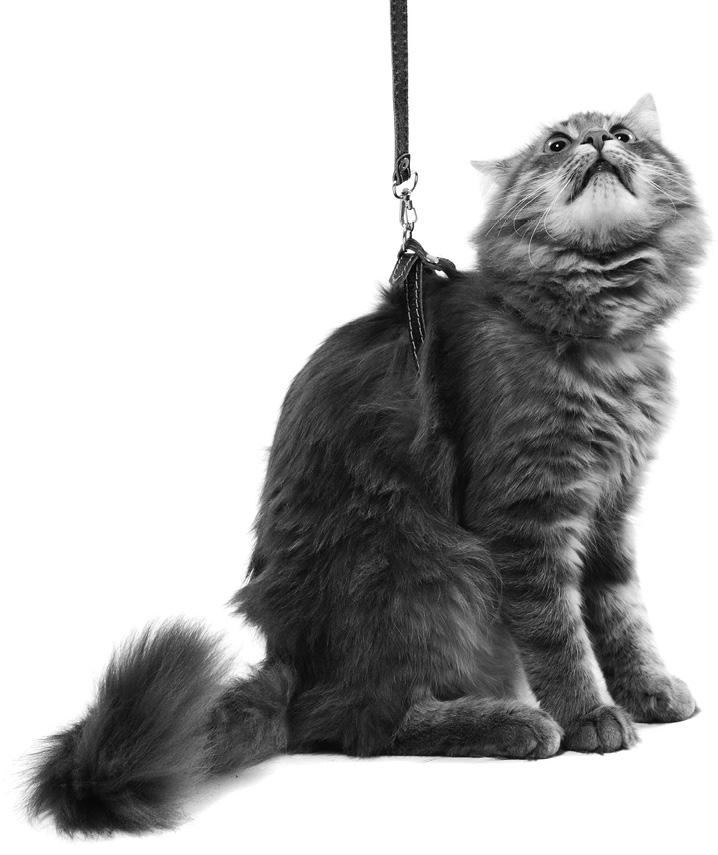
Even if you only take your cat outdoors for a limited amount of time each day or week, they can still be exposed to fleas and ticks. A preventative treatment such as Frontline Plus or Advantage II is advisable prior to outdoor excursions. Additionally, when walking an indoor cat, he or she will be more likely to respond to the scent of another cat that has previously marked his or her territory. An unaltered female cat could even go into heat (an event that might not be such a fun bonding time between you and kitty). Therefore, consider having your cat spayed or neutered before spending too much time outdoors.
Cat Patios and Window Boxes
If your cat has no desire to be walked like a dog, but still shows an interest in the outdoors, you can consider creating an outdoor pen or cat patio (known as a catio). As a variation of the cat patio, some cat owners are installing window boxes that provide a protected perch from which cats can enjoy a panoramic view of the outdoors.
Outdoor enclosures for cats range in size and are becoming a highly marketed item for cat lovers. They provide your cat with the upsides of going outside while keeping the dangers of the outdoors at bay. Try building one with shelves and a roof for protection that is either accessible via a cat door to your home or that you can take your cat to without risk of escape (http://pet360.com).
An outdoor pen should be constructed of strong posts and wire netting while also providing a covered shelter in case of bad weather. Your cats might also appreciate posts for climbing and trees or plants (including grass pots) to scratch and play in a more “natural” environment (Edney 2006). Ideally, an outdoor cat house would include furniture in shapes of tree trunks, high up resting places, tunnels or mazes to explore, and lots of furry or feathery toys.
If you decide to opt for an outdoor cat enclosure, consider the following:
Size
You can build an enclosure the size of a window box or a large pen that goes on your back porch or yard.
Location
You can place the enclosure so that it is connected off an existing window, door, or patio, or you can install a “cat door” that can provide access between the house and cat patio.
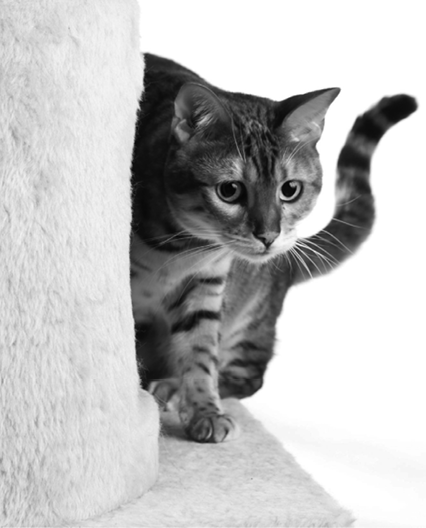
Seasonal or Year Round
Depending on where you live and the type of weather you typically enjoy, this might factor into the type of roof and walls you need to construct for your enclosure.
Accessibility
Do you want your cat to be able to cat between your home and the enclosure at will? Or do you want to place your cat in the enclosure for designated periods of time?
Contents
Some items to place in your enclosure include an outdoor litter box, “kitty grass” in a pot or planter that is safe for your cat to chew, ramps for cats to climb, lounging areas (remember that many cats like to be up high), and scratching posts or toys.
NOTE: Remember that if you permit your indoor cat to have outdoor time, you should use a flea treatment and have your cat spayed or neutered. An intake cat will be more likely to respond to the scent of another cat that has previously marked his or her territory. You could even trigger a female cat to go into heat (an event that I can attest is not a fun bonding time between you and kitty).
Interactive Cat Toys
These types of toys help you and your cat bond. Interactive toys can involve toys (wands and dangly toys) that you use to get your cat to run, chase, jump, and move.
Wands
Cats particularly love wands with feathers at the end, since it is reminiscent of the prey they would hunt. If you use wands for your cats, make sure you move the wand around a great deal so that your cat expends a large amount of energy while chasing it.
Lasers
Another type of interactive toy good for producing high levels of cat activity is a laser light that your cat can chase throughout the room. You hold the light source in your hand and point the laser at a spot on the floor or wall where you want to direct your cat’s attention. Your cat’s efforts to chase and capture the light can lead to high levels of activity for a short period of time.
Peek-a-prize toy box
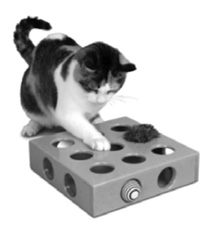
Some interactive cat toys are designed for cats to use on their own or in your company. Since cats are naturally curious creatures, toys that can surprise them are often good for mental engagement and physical activity. One such toy is known as a Peek-A-Prize Toy Box; this toy stimulates your feline’s instinct to hunt.
The product shown is by SmartCat and is available for purchase at Petco®.
It requires you to place toys or treats inside the box for mental stimulation and play. Using treats or toys with a little catnip will reward your cat for successfully getting the prize out of the box. This toy should not be left out when it is not setup for use because you do not want your cat to become frustrated when there is nothing in the box to engage with. Also, this should not be used with small kittens, as they could potentially get their heads stuck in the toy.
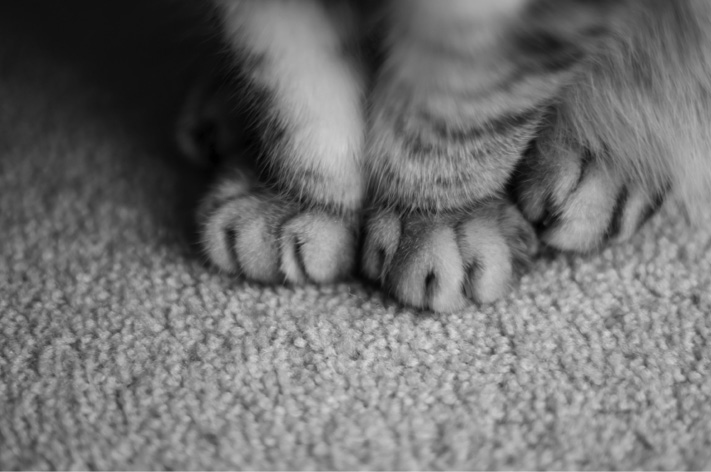
Flashing play mats
Another interesting interactive cat toy is a flashing play mat that allows cats to play during the day or night with a touch-activated toy that lights up, but is silent. The toy’s flashing lights switch randomly in order to engage your cat’s curiosity. The toy is advertised as using LED lights that generate no heat and turn off when the cat is no longer playing with it. This toy is designed for your cat to use by himself, but it could still prove to be a fun way for you to play with your cat interactively.
Squeaky toys
Squeaky toys within a ball will stimulate and engage your cat by encouraging him to bat the ball around. When he rolls the ball across the floor and it makes noise, your cat will be encouraged to run after it. This toy should keep your cat active while stimulating his desire to play with a prey-like toy. Your cat can play with this type of toy by himself or you can roll it toward him on the floor for him to chase after.
NOTE: If your cat has put on a few pounds and you need to help her lose weight, remember that replacing treats with toys might be a positive way to reward her without adding too many calories to her diet.
Volunteer With Your Cat
The benefits of pet therapy have been well-documented over the last few years, and it is not just dogs who get to assist patients in recovery activities. Therapy animal programs across the US prove that positive human-animal interventions improve the physical, emotional, and psychological lives of patients. Pet Partners is one program sponsor who reports working with more than 10,000 volunteers nationwide who work in animal-assisted interventions (http://petpartners.org).
Animal-assisted activities can include social interaction with people recuperating in hospitals, visits to retirement homes, or stress relief events. The Pet Partners therapy program works with individuals with a wide-range of conditions, including veterans with PTSD, seniors with Alzheimer’s, students with literacy challenges, people with disabilities, and those who are approaching the end of life. Even though Pet Partners reports that therapy dogs make up 94 percent of their teams, they register a total of nine species in their therapy program (dogs, cats, equines, rabbits, birds, guinea pigs, llamas, pigs, and rats).
The Pet Partners website reports that cats are great visiting animals, but they need to be relaxed when wearing a harness and leash. They should also be comfortable being groomed, petted, picked up, and gently held by strangers. Since therapy cats might need to be transported to different locations, your cat needs to feel comfortable riding in cars and should be at ease in new environments.
Animal-assisted activities (AAA)
Through various organizations (Pet Partners and Love on a Leash are two of the largest), you and your cat can volunteer at hospitals or nursing homes with teams that use pets to improve mood and promote socialization among patients. There are certifications that you and your feline can earn for these activities, but not all facilities will require them (check with your local nursing home, foster home, etc… to identify their volunteer requirements). If you are interested, perhaps you can accompany an already certified pair on an outing to see if this is something that would be good for you and your pet.
Animal-assisted therapy (AAT)
If you want to make volunteering with your cat a regular part of your weekly routine, there are groups that allow you to engage in AAT activities. In this type of volunteer work, you and your cat will help treat a patient’s specific needs; there are several programs in the U.S. that will certify an animal and his or her handler for therapy work. Pet Partners’ Therapy Animal Program is one of the largest certifying organizations in the country and they certify a wide-range of animals as therapy pets. Another group that trains and certifies cats as therapy animals is Love on a Leash. Read on for more details on both groups:
Pet partners
Pet Partners is the nation’s largest nonprofit group that registers handlers and their pets for animal-assisted interactions. On their website (www.petpartners.org), you can watch webinars to learn about their therapy programs and what is required for certification.
The Pet Partners Therapy Animal Handler Course includes topics such as how to decide if the program is right for you, how to be prepared, how to identify and decrease stress in your animal, how to keep your animal healthy and safe, and much more.
A certification is good for two years. Once you complete the course, you will also need to have a health screening for your pet to ensure she is up-to-date on her vaccinations and free from parasites, infections, and illnesses. Your regular veterinarian can complete this.
The final step is a team evaluation, and then you will be all set to participate in activities at your local hospitals, nursing homes, classrooms, and other facilities.
Love on a leash
This group uses dogs, cats, and rabbits as therapy animals. Liz Palika of Love on a Leash explained that she first started using her ten-year-old cat Flea in therapy sessions after a client requested one because she missed her cats. She worked with her cat to train him on a harness and leash and he was a huge success in her therapy sessions. His personality was perfect for the job since he would rest on a patient’s lap, purring until she picked him up. While not every cat will be as good a fit for this line of work as Flea, you should be able to access if your cat has the right personality pretty quickly.
Among other requirements, a therapy cat needs to be very friendly, comfortable around strangers, and calm. Other qualifications include:
- The ability to ride well in a car without getting stressed
- Being housetrained and capable of avoiding “accidents”
- Able to wear a harness and leash as a means of transport and restraint (the cat does not necessarily need to be willing to walk on a leash)
- Comfortable around dogs since many therapy sessions are led by dogs
(www.loveonaleash.org/Therapy-Pet)
The Importance of
Personally Interacting with Your Cat
You might not always be able to personally engage with your cat — that is why the next chapter of this book is dedicated to helping your cat achieve activity on her own. However, most pets are not naturally solitary creatures. In the wild, even feral cats can form groups and hunting parties. When a cat is removed from her litter, you are replacing her family with yours. It is important to her emotional health that she not feels isolated or alone.